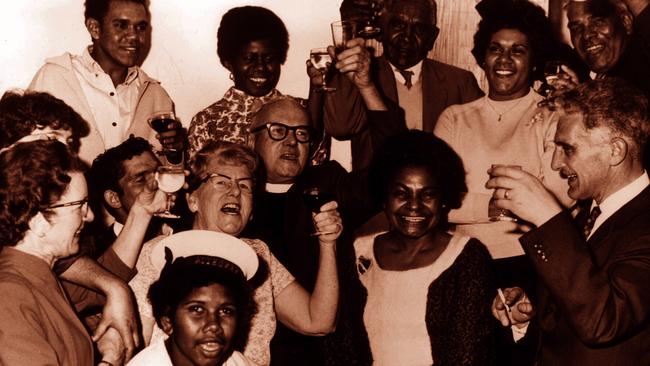Passion for social justice bloomed on factory floor
FAITH Bandler was the face of the 1967 referendum, but never stopped working for civil rights.

Today in History
Don't miss out on the headlines from Today in History. Followed categories will be added to My News.
When Australia held a referendum in 1967 to change discriminatory passages of the constitution relegating Aborigines to the status of non-citizens, one of the most visible and tireless campaigners was Faith Bandler.
With her beaming smile, Bandler was photographed alongside fellow activists, and prime minister Harold Holt, full of hope and good cheer, making it impossible for any decent person not to vote “yes”.
Bandler was not just a poster woman for the ’67 referendum. By the time of that vote she had been active for a decade working for social justice. Charismatic and sharp of intellect, yet not actually from an indigenous background, up until her death last week she dedicated her life to campaigning for human rights. A passionate believer in reconciliation, she remains an inspiration for all Australians.
She was born Ida Lessing Faith Mussing in Tumbulgum, northern NSW in 1918. Her father Wacvie “Peter” Mussing was originally from Vanuatu. Like many other South Sea Islanders, then known as “Kanakas”, he had been kidnapped to work on a sugar cane farm in Queensland in 1883, a practice known as “blackbirding”.
In Australia he suffered slave conditions until the Queensland government banned the use of kidnapped labourers. He successfully challenged the government’s deportation provisions in the Pacific Island Labourers Act of 1901 and chose to stay. He married Ida Venno, who was “part Scottish, part Indian and of course very much Australian”. He died in 1924.
Since Bandler shared her first name with her mother, she became known by her third name Faith. One of eight children, she left school to become a dressmaker in the 1930s.
In World War II she felt she should be contributing to the war effort so she joined the Australian Women’s Land Army, working as a fruit and vegetable picker. The work was hard and the pay discriminatory. Women were paid far less than the men they were replacing and Bandler noticed Aboriginals earned even less.
After the war the women were thrown out of work when the men returned home.
Bandler found employment in a Sydney shirt factory. It was at this time she started to become an activist for equal pay, both for women and indigenous workers. She also became involved with a dance group run by famous teacher Margaret Walker, travelling to Berlin as a dancer. The troupe went to eastern bloc communist countries which led to Bandler’s passport being confiscated.
Bandler became part of the cultural life of Sydney, learning to sing, writing and particularly enjoying classical music concerts. In 1951 at a concert in Sydney she met Austrian-born Jewish engineer Hans Bandler. They married in 1952 and moved to North Sydney.
In the ’50s she became involved with the NSW Peace Council, speaking out about what she had seen when she was in Europe. It brought her into contact with Aboriginal activist Pearl Gibbs and feminist and human rights champion Jessie Street.
At Street’s urging Bandler and Gibbs set up the Aboriginal Australian Fellowship in 1956 to co-ordinate political activities of indigenous groups and sympathetic organisations. In 1957 Bandler helped establish the Federal Council for the Advancement of Aboriginal and Torres Strait Islanders (FCAATSI).
With assistance from the great female legal mind Christian Jollie Smith, Street wrote an amendment to the Australian Constitution redressing the status of Aborigines. This became the focus of a decade-long campaign that would culminate in the 1967 referendum, which brought Bandler to national prominence.
Bandler did not rest on her laurels. In 1970 she became head of FCAATSI, but faced opposition from those who resented her not being an indigenous Australian and left the council in 1973.
She turned to working for descendants of other victims of blackbirding, establishing the Australian South Sea Islanders National Council in 1975. She also became a member of the Women’s Electoral Lobby. Bandler also turned to writing, publishing her first novel Wacvie in 1978.
Although she refused an MBE in 1976, she accepted an Order of Australia Medal (AM) in 1984 and was named an Australian National Living Treasure in 1997.
She remained devoted to her husband Hans, who died in 2009, and passionate to the end about issues such as government treatment of refugees and republicanism. She died on Friday and is survived by her daughter Lilon.
Originally published as Passion for social justice bloomed on factory floor



